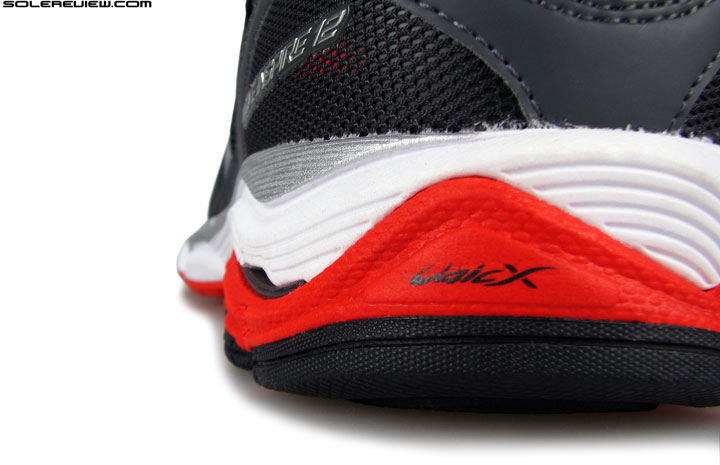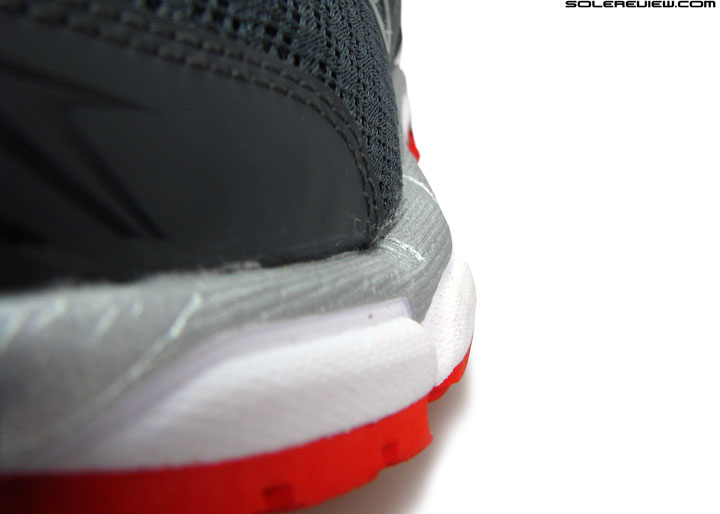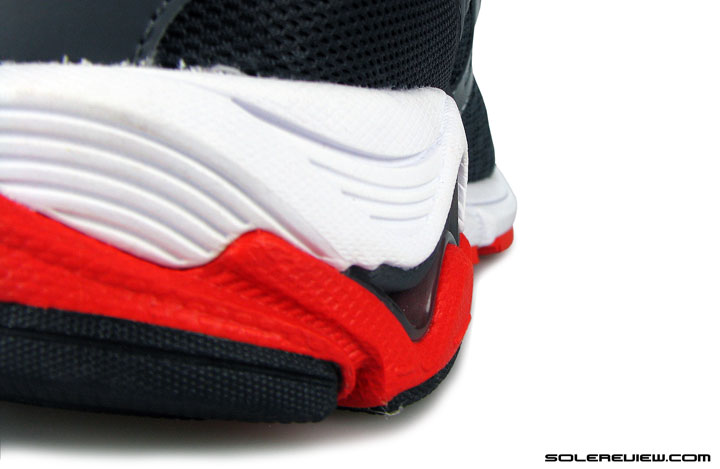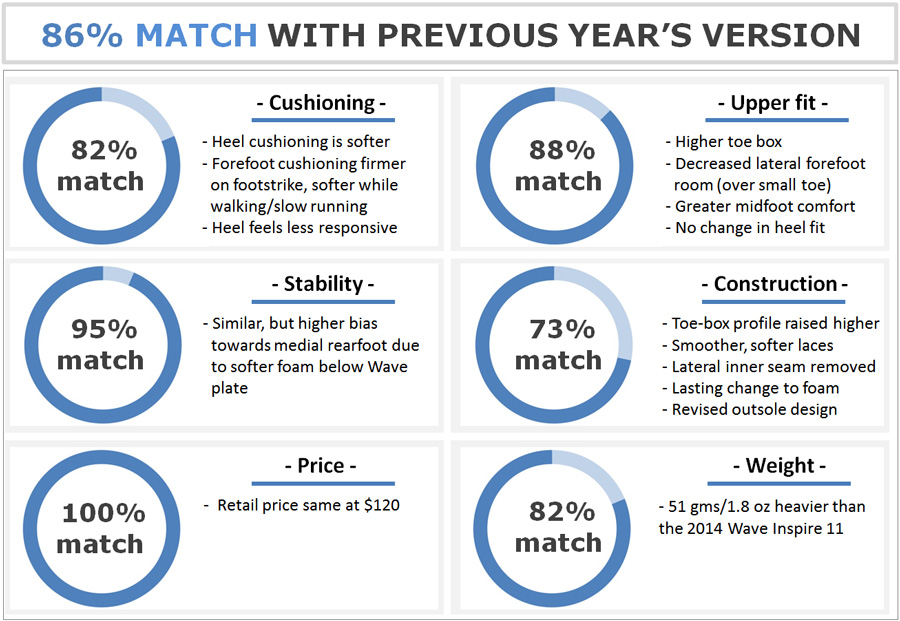That’s because the outsole design moves from a pod-like articulated layout to a kind where there are a few number of rubber pieces. Add to that the increased thickness and reduction of one flex groove, and the entire forefoot becomes harder to bend – and firmer.
As a result of this update, transition quality is also affected. While the Inspire 12 is no slouch, the added mass makes it feel a bit sluggish – in contrast to the relatively faster, heightened ground feel of the Inspire 11.
A better way to put this is that the 2015 Sayonara 3’s forefoot feels like the 2014 Inspire 11, with its split outsole and higher count of flex grooves. This also implies that the Sayonara 3 has also bulked up over the Sayonara 2, but that’s a story for another day.
Switch to the Inspire 12’s rear-foot, and the main difference between the latter and Inspire 11 is a softer medial side heel and a lower degree of responsiveness. The red colored foam insert below the Wave plate is softer than last year, and there’s more of it under the medial heel. That delivers a softer ride experience on that side of the midsole.
Which is ironic, because this is at cross-purposes with the Inspire 12’s design goal. While it is not expected of Mizuno Wave to match the ride impact of a dual density post, the shoe still attempts to create a firmer medial side.
The ‘waves’ are higher on the medial side, meant to limit the midsole compression in that area. So inserting a softer foam somewhat counters that purpose, and you sense that the Inspire 12 has a softer medial side than the Inspire 11.

Regardless of the changes, the Mizuno Inspire 12 is still very supportive. The Wave plate acts as a gatekeeper, keeping excessive compression under control.

Much like other Mizuno models, the forefoot has a broad outwards flare. Makes the ride planted and stable.
This isn’t to say that the Inspire 12 isn’t a supportive shoe. That said, everything is relative, and the Inspire 12 feels less stable than the Inspire 11. The higher midsole hardness and overall lower profile gave the Inspire 11 a planted feel.
Some of the Inspire 11’s desirable characteristics make their way to the Inspire 12. The forefoot has an outward facing flare which can be best described as industry leading, producing a wide and stable base.
The rear-foot might feel softer, but is in no way unstable or biased. As far as a supportive feel is concerned, the hard Mizuno Wave plate acts as a midsole gatekeeper. An equalizer of sorts to counter the change(s) in foam densities around it, if you will.
And yet the Wave plate isn’t immune to changes in cushioning behavior. The Inspire 12 feels less responsive and snappy than the Inspire 11, and we’ll tell you why.
Any midsole cushioning feel is based on the path of least resistance. Let us illustrate this principle with an example. Assume a shoe midsole with two stacked foam layers, one very soft and another firm, yet responsive.
During walking or low speed running, the softer foam gets activated as a cushioning agent first, deforming every time you load your weight on it. The firmer layer might not get activated because the minimum threshold for its compression is not reached at lower speeds. But once you increase your pace and cadence, you begin to tap into the responsive nature of the firmer midsole material. You start reaping the performance benefits of such materials (adidas Boost, Nike Zoom, Mizuno Wave) with higher speed.
And what if the shoe swapped the softer midsole foam with a very hard foam but left the responsive material unchanged? You end up getting feedback from the responsive material first, without the filter of the softer foam. The roles are reversed, and the responsive material is the first to react.
The same rule applies to the Wave design. Most Mizuno shoes use very firm midsole foams because it helps isolate the snappy behavior of the Wave plate. This way, the Wave plate serves as the path of least resistance – consequently delivering a heightened sense of responsiveness when you footstrike.

With the lower foam softer than before, cushioning follows the path of least resistance. The red foam compresses first, in the process, it dilutes the responsive snap of the Wave plate.
So what happens on the Inspire 12 is this: the softer (red) foam tends to compress first, which dilutes the Wave experience. The Wave plate does compress, but only after the softer foam goes all the way.
So when compared to the firm foam-Wave-firm foam set-up of the Inspire 11, the firm foam-Wave-soft foam configuration of the Inspire 12 alters the way in which the midsole responds to activity. In a nutshell, there’s more foam feel and less Wave snap this time around.
Like the Inspire 11, it doesn’t take a whole lot of effort to run in the 12. Transitions are consistent, potential sink zones are prevented by the firm Wave plate, and the top midsole layer has a uniform feel throughout. Yet you can’t escape the feeling that you’re lugging slightly more weight around, and the scenery doesn’t go by as fast as it did on the Inspire 11.
All in all, the Inspire 12 is a curious update full of surprises. It is still supportive in Mizuno’s own unique way, but no more than the ‘neutral’ Wave Rider 19, which oddly turns out to be a firmer shoe. The increased weight and changed ride manners also brings the Inspire 12 closer to the Paradox 2, blurring the distinction between these two stability models.
(Disclaimer: For this review, Solereview bought the shoe at full US retail price.)
Looking to upgrade your older Mizuno Wave Inspire 11 to the latest version, but not sure how the 2015 model compares? We can help here. The following infographic is a ready-reckoner for what changes you might expect in the new model vs. old. To make this more fun, we’ve put in a system of percentage match, which calculates a weighted average for a set of attributes.
A higher or lower match percentage is neither good or bad. The % number just tells you how similar or distanced the new shoe is from the previous version. Total match % is a result of weighted averages.


18 comments
“All in all, the Inspire 12 is a curious update full of surprises. It is still supportive in Mizuno’s own unique way, but no more than the ‘neutral’ Wave Rider 19, which oddly turns out to be a firmer shoe”
Agree. I have worn the WR 13, 15, and 17 and once tried the Inspire. I actually preferred the cushion of the Inspire, but not the stability features.
All of Mizuno’s changes seem “curious.” It seems they change for the sake of change. The WR13 was preferred by many and never has been the same.
Personal thought, it seems Mizuno running shoes are not the focus of the company. Their golf, baseball, and other sports seem to be the foundation for the company. The previous year’s models can be found at very, very cheap prices (possibly indicating a lack of sales) as compared to Brooks, Asics, and Nike.
Perhaps this is the reason why Mizuno is making their shoes softer? To appeal to a mainstream audience?
Perhaps.
Mizuno’s lack of popularity is indicative of the minimal replies to this review compared to other reviews.
Can’t help but feel that this version of the Inspire is not true to this shoe’s heritage. All models since the 6 (yes, I’ve used them for a long time) have had the 11’s “snappy” responsive ride. WHen I tried the 12 at my local shop it felt too similar to the Paradox. consequently I bought a pair of 11s on run-out. Will try to source some more of these, as I didn’t like the 12’s bulky feel.
Thanks for the feedback – have no idea at all about Inspires before V11.
hey i had ankle operation (ATFL) and used puma FAAs1000 after that which seemed quite comfy. then i started using the reebok ziglite. both shoes on treadmill or soft ground and nothing more than 5k…however i started developing shin pain i think because of the ziglite. even though the ankle is fine now the knee of the other leg plus the shins trouble me… i am looking foe anew shoe to gradually build up for a half marathon….have read so many reviews that i am confused…any suggestions would be greatly appreiated..
Sorry Rudra, we cannot help here – injuries might or might not be caused because of footwear. It is best to see a physio for ways to treat your pain.
I’ve run in the Inspire 8, 9 and 11 and loved them all. I recently tried the 12 on in a store and felt that my heel was slipping. I compared the 12 side-by-side with my 11 and they definitely looked about a half size larger. Just to be sure about the heel slippage issue, I also tried a half size smaller and still felt that my heel was slipping. I know your review indicated that the heel area hasn’t changed from the 11. Looking at pictures of the 12 and the 11, the last eyelet in the 12 seems farther away from the heel than in the 11. Could that be the reason why my heel feels like it’s slipping? I also tried on the Guide 19 at the store and felt that my heel was slipping, albeit not as much as the Inspire 12. Bottom line is I didn’t feel comfortable in the Inspire 12’s and I don’t know what to do now. Years ago, I ran in Asics GT-2000s, but they seemed slow once I discovered the Inspire series. I also tried Sacuony Hurricanes but they felt like concrete blocks on my feet.
Try barefoot :)
It is possible that the softer insole is causing the foot to sink in further, creating the sensation of slippage.
Have you tried the Sequence 8 Boost?
hi solerunner, i dont know where else i should ask so ill just wrote it here:
could you write more review about trail run shoe, or just any shoe more outdoor oriented (like hiking shoe perhjaps). most of the review out there is very subjective and didn’t have actual number/ material photos to back em up. all i see is people sayin “this trail runners grip more than other brand”, or “the material seems more durable to rocky condition”. i just wish i had trail shoe review which actually compare the shoe objectively, like what you do on running shoe. i dont know how big the market potential though. thanks for listening
Hi!
Thank you for the feedback! We currently don’t write outdoor footwear reviews because of resource constraints, but once we do, we’ll be happy to get into trail running shoe reviews!
Thanks for the great reviews! I tried Odyssey but it was a disaster for me. One source that has great info on running shoes is this one https://www.youtube.com/watch?v=tQBKVeA_qrI, they are quite thorough and combined with your analysis, this is a great help to all of us. They suggest Saucony Ride 7, like you did, which I might try.
Thanks for the video!
Great job with the site, thanks for all the reviews!!!
I’m looking for a bit of advice:
I’ve been running with Lunar Eclipse (v3 and V4 for the last few years). It’s a shoe that I liked and felt comfortable with, even though I’ve always suffered from shin splints. I’ve managed to keep them at bay by using a MacDavid calf sleeve… otherwise I would start getting pain in my shins after 3-4 runs without using them.
Recently I had to shop again for new shoes, but the Lunar Eclipse are gone. So I tried several pairs (including the Nike Air Zoom Odyssey) and ultimately settled for this Inspire 12, they felt the best at the store.
After two months of use I’m developing ITBS and also for some reason my toes are hurting at the tip (surprising since one of the reasons I chose them was the roomy toe box). I had never had any of these issues before, so I’m blaming them on the Inspire 12… even though I’ve run my first marathon during this time.
So now after the marathon I’m slowly getting back to running and working hard on my running form in the hopes of getting rid of my shin splints once and for all (I’d like to run without the calf sleeves!). In the process I want to go a bit more minimalistic with my shoes to see if that’s also a factor that will help my form and running economy.
Any recommendations for a new pair of shoes? I get the Inspire 12 at Roadrunner so I can still exchange them for a new pair. Thanks so much in advance!
How much of running were you doing before the marathon? Besides the shoes, overtraining could potentially be an issue.
That said, if you’re looking for a relatively minimal shoe, then the New Balance 1500 V1 or V2 is worth a try.
Thanks!
I had been training Ning for the marathon for a while, and I got the Mizuno’s just as I was about to start the tapering, like about 3 weeks before the race. They felt good at first, but after a few runs I got pain in the top of my feet, so I had to change the traditional lacing which helped… But the more I run in them the more I noticed they weren’t right for me… And then those issues appeared.
I’ll look into the NB 1500… I was also thinking of the Saucony Kinvara or Ashoka Clifton as potentially good transition shoes… Any thoughts on those? And maybe a Nike equivalent if you can think of one? Thanks!!!
Apart from the 1500, you could try the Nike LunarTempo 2. Yes, the Kinvara is also worth considering.
The Clifton? Not sure. You mentioned minimalist, but these shoes are anything but.
Comments are closed.